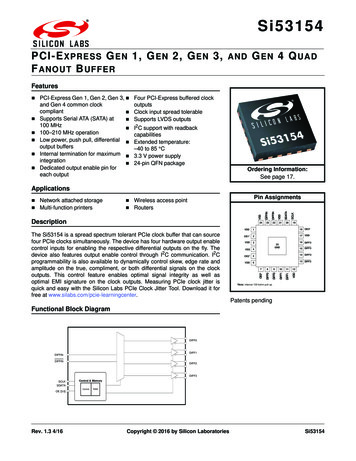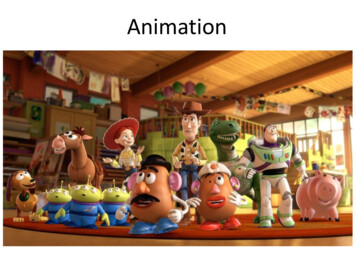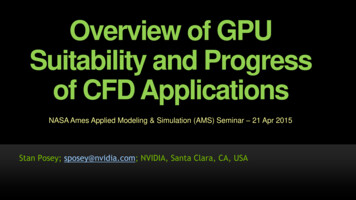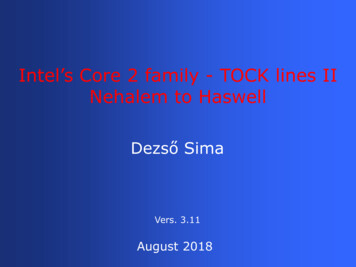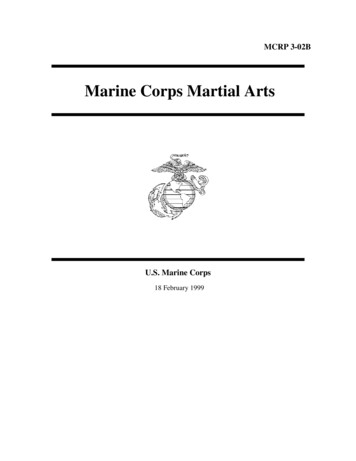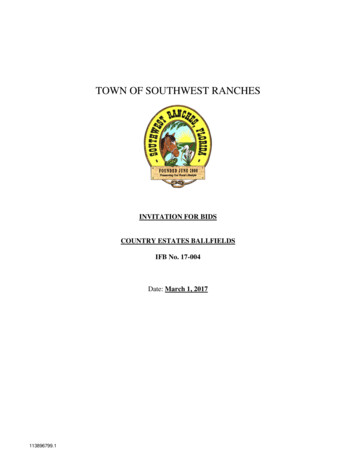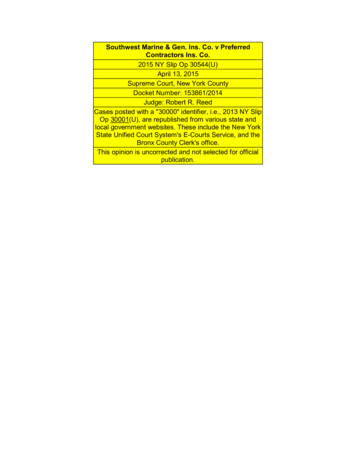
Transcription
Southwest Marine & Gen. Ins. Co. v PreferredContractors Ins. Co.2015 NY Slip Op 30544(U)April 13, 2015Supreme Court, New York CountyDocket Number: 153861/2014Judge: Robert R. ReedCases posted with a "30000" identifier, i.e., 2013 NY SlipOp 30001(U), are republished from various state andlocal government websites. These include the New YorkState Unified Court System's E-Courts Service, and theBronx County Clerk's office.This opinion is uncorrected and not selected for officialpublication.
[* 1]SUPREME COURT OF THE STATE OF NEW YORKCOUNTY OF NEW YORK: 1.A.S. PART ----------------------)(SOUTHWEST MARINE AND GENERALINSURANCE COMPANY, SOILSOLUTIONINDUSTRIES, INC., E)()(ONMOBIL CORPORATION,and ROU)( ASSOC IA TES, INC.,DECISION/ORDERPlaintiffs,-against-Index No.: 153861/2014PREFERRED CONTRACTORS INSURANCECOMPANY and GILMAR DESIGN T R. REED, J.:This is an action for a declaratory judgment and damages in which the plaintiffs,Southwest Marine and General Insurance Company (Southwest Marine), SoilSolution Industries,Inc. (Soi!Solution), ExxonMobil Corporation (ExxonMobil) and Roux Associates, Inc. (Roux),seek a declaration regarding the obligations of defendant Preferred Contractors InsuranceCompany (PCIC) under an insurance policy PCIC issued to defendant Gilmar DesignCorporation (Gilmar). Plaintiffs claim that SoilSolution, ExxonMobil and Roux are entitled toadditional insured status under PCIC's policy with respect to a bodily injury claim brought bynonparty Voloaymyr Vengrenyuk (Vengrenyuk), an employee of Gilmar.In motion sequence 001, PCIC moves to dismiss the complaint, pursuant to CPLR 3211(a) (I) and (7), or, in the alternative, for summary judgment pursuant to CPLR 3211 (c) and3212. In motion sequence 002, plaintiffs move for summary judgment in their favor.FACTUAL ALLEGATIONSThis matter arises out of an underlying personal injury action captioned Vengrenyuk v
[* 2]ExxonMobil Oil Corp., et al., Index No. 30488/10, venued in Kings County Supreme Court.The complaint in the underlying action alleges that Vengrenyuk fell from a scaffold and injuredhimself on November 2, 2009 while working for Gilmar at premises located at 28-38 VarickStreet in Brooklyn, New York. ExxonMobil was the owner of the premises where Vengrenyukwas allegedly injured. ExxonMobil allegedly contracted with nonparty I'll Go, Inc. to performwork as a general contractor at the site. I'll Go, Inc. allegedly subcontracted with Roux, a NewYork corporation doing business in Islandia, New York, and Soi!Solution, located in Neponsit,New York, to perform work and services at the site. Soi!Solution allegedly subcontracted withGilmar, located in Brooklyn, New York, to perform certain work and services at the site.The subcontract between Soi!Solution and Gilmar is dated May 19, 2009 (see Odelsonaffirmation, Ex. F).Citing section 4.6 of the Gil mar subcontract, plaintiffs contend that Gil marwas required to indemnify and hold harmless ExxonMobil, Soi!Soution and Roux from all claimsarising out of Gilmar's work. Plaintiffs also allege that a rider to the Gilmar subcontractrequired Gilmar to procure and maintain insurance that would protect all entities that Gilmar wascontractually required to indemnify and hold harmless, and that the insurance was to be primaryand non-contributory (see Pis. Mem. of Law at 4). However, it is not clear where theseinsurance requirements come from since there is no rider attached to the Gilmar subcontract.While plaintiffs submit two other contracts: (1) a rather voluminous "Standard ProcurementAgreement For Downstream or Chemical Services With Incidental Good" between ExxonMobiland Roux effective September 1, 2007 and August 31, 2012 (the ExxonMobil agreement) (seeOdelson affirmation, Ex. H); and (2) a 13-page "Master General Subcontractor Agreement forConstruction Projects," entered into by Roux and Soi!Solution on or about January 10, 2009 (the2
[* 3]SoilSolution subcontract) (id., Ex. G), it is not clear where the quoted language from plaintiffs'moving brief at page 4 is taken.Vengrenyuk originally sued ExxonMobil, SoilSolution and Roux.ExxonMobil andRoux impleaded Gilmar in January 2012, and a second third-party action against Gilmar wasbrought in June 2012. In the third-party actions, ExxonMobil, SoilSolution and Roux seekcommon-law and contractual indemnification and contribution from Gilmar, and assert a breachof contract claim for failure to procure insurance on their behalf. These plaintiffs obtaineddefault judgments on liability against Gilmar in September 2012 and June 2013.PCIC issued a Commercial General Liability Policy, number PC71043-MA, to BaratGilmar/Gilmar Design Group for the period February 25, 2009 to February 25, 2010 (the PCICpolicy). The PCIC policy, as submitted to the court by PCIC (see Suben affirmation, Ex. A),contains three "additional insured" endorsements, all designated as Endorsement No. I 0. Thefirst endorsement appears at page 70 of the PCIC policy. Under the heading "ADDITIONALINSUREDS," this endorsement provides in full:"As of the date of the Endorsement, the Policy is hereby amended to provide theperson or organization shown in this Schedule with coverage as if the person ororganization was a Member, but only; (1) with respect to liability arising out ofyour ongoing operations performed for the original Member listed on theDeclarations of the Policy; and (2) only providing that the Additional Insuredperforms all obligations required under the Policy.Additional Insured:Scheduled Project:Policy no.: PC71043-MADate: 2/25/200912:01 a.m."Time:(id., Ex.Bat 70 [bold in original]). This endorsement is signed by "Phillip Salvagio," identifiedthereon as an authorized representative of PCIC. Notably, the spaces to identify any "Additional3
[* 4]Insured" and "Scheduled Project" are blank.The second Endorsement No. 10 appears immediately after page 85 of the PCIC policy.It is identical in almost all respects to the first Endorsement No. I 0. The only four differencesare: (I) different pagination; (2) different formatting; (3) there is no line for "Scheduled Project:"as in the first Endorsement No. 10; and (4) PCIC's URL address appears at thebottom center of the page. However, both of these endorsements state that they are i Form 20 0517 06."The third Endorsement No. 10 is the very last page of the PCIC policy. Thisendorsement is entitled "BLANKET ADDITIONAL INSURED." It provides as follows:"As of the date of the Endorsement, the Policy is hereby amended toprovide the person or organization shown in this Schedule with coverage as if theperson or organization was a Member, but only; (I) with respect to liabilityarising out of your ongoing operations performed for the original Member listedon the Declarations of the Policy; (2) only for the Scheduled Project listedbelow; and (3) only providing that the Additional Insured performs all obligationsrequired under the Policy.Company (Member):Policy Number:Effective Date:Time:Gilmar Design CorpPC71043-MA2/25/200912:00AM"(id. at undated last page). This endorsement is not signed by Mr. Selvaggio, or any otherrepresentative of PCIC. It follows directly behind the two-page insurance binder, also datedFebruary 25, 2009 and also signed by Mr. Selvaggio. In that binder, the insured is listed as"Gilmar Design Corp" and the box for "Special Conditions/Other Coverages" is blank.4
[* 5]By correspondence dated February 8, 2011, Southwest Marine's agent 1 tendered ihedefense and indemnification of ExxonMobil in the underlying action to Gilmar and PCIC (seeOdelson affirmation, Ex. J). This letter allegedly enclosed a copy of acert ficateof insurancedated May 26, 2009, issued by "Max J. Pollack & Sons Inc." which names ExxonMobil andRoux as additional insureds on the PCIC policy and names SoilSolution as the certificate holder(id., Exs. I and J). By correspondence dated April 2, 2012, Southwest Marine again allegedlytendered the defense of ExxonMobil, as well as Roux and SoilSolution, in the underlying actionto PCIC (id., Ex. K). By correspondence dated May 2, 2012 from Network Adjusters, Inc.,PCIC acknowledged receipt of the tender of the Vengrenyuk claim on behalf of Soil Solutiononly, making no mention of ExxonMobil or Roux (id., Ex. L). In this letter, PCIC'srepresentative stated that the insurance company was denying coverage, because SoilSoutiondoes not qualify as an additional insured under the PCIC policy. Citing the additional insuredendorsements, PCIC advised that:"The Policy provides additional insured coverage, if at all, only to a partyidentified as an additional insured in the schedule in Endorsement No. 10.SoilSolution is not identified in the schedule or anywhere else in the Policy.Although the tender correspondence states that 'Certificates of Insurance providedby Gilmar Design Corporation for this project . indicate Roux Associates,Exxon Mobil Corporation and SoilSolution Industries, Inc. are to be additionalinsureds on your Commercial General Liability policy,' such is not reflected in thePolicy. Moreover, a certificate of insurance in itself confers no rights tocoverage on the certificate holder . "(id. at 3).PCIC also maintained, in this letter, the following additional arguments: (1) that pursuant1According to the complaint in this action, Southwest Marine issued a commercialgeneral liability policy to ExxonMobil, Roux and SoilSolution (complaint, 48).5
[* 6]to Endorsement No. 23, entitled "Action Over," the limit of liability was I 0,000, an argumentthat PCIC has since withdrawn (see PCIP's Mem. of Law in Opp. at 2); (2) the PCIC policyapplies only to "a claim made for a Covered Loss not covered by other insurance;" and (3) the"other insurance" provisions in the PCIC policy provide that it is excess coverage where there isother insurance available to the insured for this loss, namely SoilSolution's own policy issued bySouthwest, and thus there is no duty to defend the Vengrenyuk claim.This action was commenced on April 22, 2014. In their complaint, plaintiffs seek adeclaration that ExxonMobil, Soilsolution and Roux are entitled to additional insured coverageunder the PCIC policy. Plaintiffs also seek a declaration that the PCIC policy provides primarycoverage, and that Southwest Marine's policy, identified in the complaint as commercial generalliability "policy number 430425LP09, in effect for the policy period January 7, 2009 to January7, 2010" (complaint, 48), 2 is excess to the PCIC policy.DISCUSSIONPCIC contends that Montana law applies to this dispute by virtue of Section XII of thePCIC policy. However, PCIC does not refute that New York law must be applied pursuant toInsurance Law§ 3103 (b ), which provides that no policy of !nsurance delivered in New Yorkinsuring activity in New York shall provide that it be governed by the laws of another state. Inaddition, New York's choice-of-law approach generally dictates that a contract of liabilityinsurance be governed by the law of the state which the parties understood to be the principal2In support of plaintiffs' cross motion, they submit an insurance policy issued bySouthwest Marine to SoilSolution, however the policy number identified thereon is"GL0003 l 709" (see Odelson affirmation, Ex. M).6
[* 7]location of the insured risk (Zurich Ins. Co. v Shearson Lehman Hutton, 84 NY2d 309, 318[ 1994]; Certain Underwriters at Lloyd's, London v Foster Wheeler Corp., 36 AD3d 17, 21-22[1st Dept 2006], ajfd 9 NY3d 928 [2007]).CPLR 3211 (a) (1) provides for dismissal where "a defense is founded upondocumentary evidence" if the documentary evidence "conclusively establishes a defense to theasserted claims as a matter of law" (Leon v Martinez, 84 NY2d 83, 88 [ 1994]) and "resolves allfactual issues as a matter of law, and conclusively disposes of the plaintiffs claim" (Fortis Fin.Servs. v Fimat Futures USA, 290 AD2d 383, 383 [1st Dept 2002]).PCIC argues that the documentary evidence, namely the PCIC policy and its threeadditional insured endorsements, unambiguously provides that additional insured coverage, ifany, extends only to "the person or organization shown in this Schedule." Since the schedule inthe two "ADDITIONAL INSUREDS" endorsements is left blank and the schedule in the"BLANKET ADDITIONAL INSURED" endorsement identifies only Gilmar, and none of theplaintiffs, PCIC maintains that none of the plaintiffs is an additional insured under its insurancepolicy. Plaintiffs disagree, and argue that they are entitled to coverage under the "BLANKETADDITIONAL INSURED" endorsement, because this type of endorsement provides automaticcoverage to entities that a named insured is required by contract to add as an additional insuredunder its insurance policy. Plaintiffs argue that the PCIC policy is ambiguous, because itcontains both blanket coverage and coverage pursuant to a schedule, and thus the policy must beconstrued against PCIC. Plaintiffs rely heavily on Ames Constr., Inc. v Jntermountain Indus.,Inc. {712 F Supp 2d 1160 [D Montana 2010], affd445 Fed Appx 971 [9th Cir 2011]). At thevery least, plaintiffs argue that PCIC's motion to dismiss is premature, and that they should be7
[* 8]entitled to obtain discovery regarding the issuance of the certificate of insurance and obtain acopy of PCIC's underwriting file.In Ames, a commercial general liability insurance policy obtained by a subcontractorcontained an endorsement for additional insured coverage that provided, in pertinent part:"ADDITIONAL INSURED-OWNERS, LESSEES OR CONTRACTORSBlanket as required by written contract and only if certificate ofinsurance has been provided to Company prior to date of loss.A. Section II-Who Is An Insured is amended to include as an insured theperson or organization shown in the Schedule, but only with respect to liabilityout of your ongoing operations performed for that insured."(712 F Supp 2d at 1163 [bold in original]). As here, even though a certificate of insuranceissued by the subcontractor's's insurance agent named the general contractor, AmesConstruction, Inc. (Ames), as the certificate holder and additional insured, the policy did notcontain any schedule that listed the general contractor Ames or any additional insureds. Theinsurance company denied coverage to Ames, not because there was no schedule naming it as anadditional insured, but because, inter alia, it "did not have a Certificate of Insurance on file listingAmes as an additional insured" (712 F Supp 2d at 1164). Indeed, the insurance company'srepresentative "described this as a 'scribners error,' [sic] and stated that the Policy was referringto the Certificate of Insurance, not a Schedule" (id.).Nevertheless, in ruling for Ames, the district court found that the endorsement wasambiguous, because it "uses two conflicting terms for the type of coverage provided: it statesthere is blanket coverage . and coverage that includes 'as an insured the person or organizationshown in the Schedule,' although there is no such schedule attached to the Policy" (Ames, 712 F8
[* 9]Supp 2d at 1166). The district court went on to hold that:"It is inconsistent for the Policy to refer to both blanket coverage and coveragepursuant to a schedule since the terms 'blanket' and 'schedule' refer to differenttypes of coverage. See e.g. Lee R. Russ & Thomas F. Segalla, Couch onInsurance vol. 3, § 40:29 (West 1997). Blanket coverage 'generally providescoverage for any person or organization to whom or to which the named insuredis obligated to name as an additional insured,' in contrast to a schedule, whichspecifically lists additional insured parties. Id. Endorsement # 4 is thus subject totwo interpretations as to the type of coverage it offers, and the ambiguity must beconstrued in favor Ames to provide the type of coverage it contracted for: lanketcoverage"(712 F Supp 2d at 1167).Ames is not persuasive authority, because the additional insured endorsement at issue inthat case is very different from the additional insured endorsements to the PCIC policy. TheAmes endorsement included the language: "Blanket as required by written contract," while thePCIC policy endorsement Jacks any language to the effect that the insurer was extendingcoverage to persons or organizations that Gilmar was obligated to name as an additional insuredby contract. For example, while plaintiffs rely on 140 Broadway Prop. v Schindler El. Co. (73AD3d 717 [2d Dept 2010]), that case involved "an additional insured endorsement whichprovided coverage to any entity [the insured subcontractor] had agreed by written contract toinsure" (;d. at 718), a more typical additional insured endorsement (see also West 64th St., LLC vAxis U.S. Ins., 63 AD3d 471 [lst Dept 2009]). The only words in the PCIC endorsement tosuggest blanket coverage in its usual sense is the word "Blanket" in the heading of theendorsement. Thus, the question is whether that one word makes the PCIC policy ambiguous.Insurance contracts are to be interpreted according to the reasonable expectations andpurposes of an ordinary businessperson when making ordinary business contracts (GeneralMotors Acceptance Corp. v Nationwide Ins. Co., 4 NY3d 451, 457 [2005]; Belt Painting Corp. v9
[* 10]TIC Ins. Co., 100 NY2d 377, 383 [2003]; J.P. Morgan Sec. Inc. v Vigilant Ins. Co., 126 AD3d76, *5, 2 NYS3d 415, 419 [ l st Dept 2015]). In Baker v Nationwide Mui. Ins. Co. ( 158 AD2d794, 796-97 [3d Dept 1990]), the court held that the terminology "Blanket Accident Insurance"appearing on the face of the policy as a title was a descriptive term that the insured was entitledto rely on and implied that the coverage contracted for was broad in scope and not limited in themanner argued by the insurance company.Citing Ames and other New York case law, plaintiffs argue that since the PCIC policyendorsements are ambiguous, they must be construed by the court in favor of coverage andagainst the insurer who drafted the policy (see e.g. City of New York v Evanston Ins. Co., 39AD3d 153, 156 [2d Dept 2007]). However, courts will only resolve ambiguities against theinsurer after available extrinsic evidence has been gathered and examined. As the Court ofAppeals explained:"Generally, the courts bear the responsibility of determining the rights orobligations of parties under insurance contracts based on the specific language ofthe policies. If, however, the language in the insurance contract is ambiguous andsusceptible of two reasonable interpretations, the parties may submit extrinsicevidence as an aid in construction, and the resolution of the ambiguity is for thetrier of fact. On the other hand, if the tendered extrinsic evidence is itselfconclusory and will not resolve the equivocality of the language of the contract,the issue remains a question of law for the court. Under those circumstances, theambiguity must be resolved against the insurer which drafted the contract"(State of New York v Home Indem. Co., 66 NY2d 669, 671 [1985] [citations omitted]).In this case, there is simply not enough evidence in the record on these motions todetermine the meaning of the three different additional insured endorsements. PCIC has not metits burden of conclusively demonstrating that none of the plaintiffs is an additional insured underthe PCIC policy. PCIC offers no explanation for the existence of three different endorsements,10.
[* 11]nor does it explain why the word "Blanket" appears in the heading of the third endorsement ifblanket coverage in its usual sense was not intended. Indeed, if the intent was only to coverspecifically listed entities for specifically listed projects, why does the third endorsement exist atall? PCIC's interpretation would render the word "Blanket" in that third endorsementmeaningless. "An insurance contract should not be read so that some provisions are renderedmeaningless" (County of Columbia v Continental Ins. Co., 83 NY2d 618, 628 [1994]). Inaddition, the PCIC policy was issued in February 2009, and yet the Gilmar subcontract was notsigned until May of that year. The record is wholly unclear how or whether, without blanketcoverage, the PCIC policy or its "Schedule(s)" was to be amended to include new constructionprojects. The production of PCIC's underwriting file may clear up this mystery.A summary determination is also inappropriate in light of the existence of a certificate ofinsurance issued by "Max J. Pollack & Sons Inc." naming ExxonMobil and Roux as additionalinsureds and Soil Solution as the certificate holder (see Herrnsdorf v Bernard Janowitz Constr.Corp., 96 AD3d 1011, 1013 [2d Dept 2012] [certificate of insurance naming a party raised atriable issue of fact as to whether that party was an additional insured under the policy]; HornMaintenance Corp. v Aetna Cas. & Sur Co., 225 AD2d 443, 444 [1st Dept 1996] [certificate ofinsurance is "evidence of a contract for insurance" and can raise a triable issue of fact to defeatsummary judgment "especially where additional factors exist favoring coverage"]).Furthermore, in the event that "Max J. Pollack & Sons Inc." is an agent of PCIC, it may beestopped from denying coverage where there is reasonable reliance to the detriment of thecertificate holder (Sevenson v Envtl. Servs., Inc. v Sirius Am. Ins. Co., 74 AD3d 1751, 1753 [4thDept 201 OJ; Tribeca Broadway Assoc. v Mount Vernon Fire Ins. Co., 5 AD3d 198, 200 [1st Dept11
[* 12]2004]; Lenox Realty v Excelsior Ins. Co., 255 AD2d 644, 645-646 [3d Dept 1998]).The parties raise the following additional arguments in support of their respectivepositions. Plaintiffs maintain that PCIC's coverage, if found to exist, is primary and noncontributory, citing the Gilmar subcontract and the following language of the Southwest Marinepolicy:"b. Excess Insurance( 1) This insurance is excess over:***(b) Any other primary insurance available to you covering liability for damagesarising out of the premises or operations, or the products and completedoperations, for which you have been added as an additional insured by attachmentof an endorsement"(Odelson affirmation, Ex.Mat 11 ). PCIC, for its part, contends that, even if the plaintiffs werefound to qualify as additional insureds, the PCIC policy unambiguously applies only where thereis no other coverage for the loss. PCIC cites to Section III, entitled "COVERAGEAFFORDED," which states in pertinent part:"Notwithstanding any other provisions contained in this Policy, thecoverages set forth are limited to:(A)A claim made for a Covered Loss not covered by otherinsurance;"(Suben affirmation, Ex. A at 10). PCIC further argues that even if the court disregarded thisclause, known as an "escape" or "no liability" clause (see generally State Farm Fire & Cas. Co. vLiMauro, 65 NY2d 369, 373 [1985]; 4 Bruner & O'Connor Constr. Law§ 11 :173 at 1 [2015]),the PCIC policy also contains its own "other insurance" or excess provision, whichunequivocally makes the PCIC policy excess over all other insurance, whether collectible or not.This provision reads:12
[* 13]"XI. OTHER INSURANCEIf there is other insurance covering the Covered Loss, the Risk Retention Groupwill only cover the amount of the Covered Loss in excess of the amount due fromthat other insurance, whether the Named Insured and/or Insured can collect onit or not. The Risk Retention Group will .not pay more than the AggregateLimit under any circumstance. This Policy shall be deemed to be an excessPolicy"(Suben affirmation, Ex. A, at 52 [bold in original]).Since this priority dispute is dependent upon a finding that ExxonMobil, SoilSolution andRoux are covered, as additional insureds, under the PCIC policy, it would it be premature for the.court to make any rulings as to the priority of the PCIC and Southwest Marine policies. This isparticularly the case since, in the court's view, neither party has adequately briefed the relevantlaw on the enforceability of the type of escape clause found in the PCIC policy and how toreconcile it with each policy's excess clauses. For example, citing its escape clause, PCICmerely argues that it is enforceable under Montana law. Plaintiffs, for their part, do not evenaddress the escape clause in the PCIC policy. In New York, where one insurance policy has anescape clause and the other insurance policy has an excess clause, the general rule is that theescape clause is not given effect (see Kipper v Universal Underwriters Group, 304 AD2d 62, 65[4th Dept 2003]; Utica Mut. Ins. Co. v Travelers Ins. Co., 213 AD2d 983, 984 [4th Dept 1995];Mosca v Ford Motor Credit Co., 150 AD2d 656, 658 [2d Dept 1989]). Although the SouthwestMarine policy does, in fact, have an excess clause, so too does the PCIC policy, which begs thequestion as to which policy is excess to the other.And while plaintiffs argue that Gilmar was contractually obligated to obtain additionalinsured coverage that was primary and non-contributory, as noted above, there is nothing in theGilmar subcontract, or at least the version attached to the plaintiffs' moving papers (see Odelson13
[* 14]affirmation, Ex. F) about insurance coverage for any of the plaintiffs. Even assuming that thisfact was established on this record, it is not dispositive of the issue. Recent case law has nowclarified that looking to the terms of the relevant trade contracts in determining the priority of coinsuring insurance policies is a "mistaken approach" (Bovis Lend Lease LMB, Inc. v Great Am.Ins. Co., 53 AD3d 140, 145 [1st Dept 2008])."An insurance policy is a contract between the insurer and the insured. Thus, theextent of coverage (including a given policy's priority vis-a-vis other policies) iscontrolled by the relevant policy terms, not by the terms of the underlying tradecontract that required the named insured to purchase coverage"(id. at 145; see also Travelers v lndem. Co. v American & Foreign Ins. Co., 286 AD2d 626 [1stDept 2001]). Only ifthe policyitsel expresslyprovides that the terms of the underlying tradecontracts determine if coverage is primary or excess, as was the case in Pecker Iron Works ofN. Y. v Traveler's Ins. Co. (99 NY2d 391, 394 [2003]), would the insurance requirements of theGilmar subcontract come into play. If it is determined that ExxonMobil, SoilSolution and Rouxare entitled to additional insured coverage under the PCIC policy, the court must consider "'thepurpose each policy was intended to serve as evidenced both by its stated coverage and thepremium paid for it, as well as upon the wording of its provision concerning excess insurance"'(Bovis Lend Lease LMB, Inc. v Great Am. Ins. Co., 53 AD3d at 148, quoting State Farm Fire &Cas. Co. v LiMauro, 65 NY2d at 374). The record is not sufficiently developed on thesemotions to make such a determination.PCIC's motion to dismiss the complaint pursuant to CPLR 3211 (a) (1) and (7) is denied.Since a modicum of discovery is needed to resolve this coverage dispute, the court declines toconvert PCIC's motion into a motion for summary judgment pursuant to CPLR 3212 (c). Forthe same reasons, plaintiffs' cross motion for summary judgment is their favor is also denied.14
[* 15]CONCLUSION AND ORDERFor the foregoing reasons, it is herebyORDERED that defendants' motion (seq. no. 001) to dismiss the complaint and/or forsummary judgment is denied; and it is furtherORDERED that plaintiffs' motion (seq. no. 002) for summary judgment is also denied;and it is furtherORDERED that defendants are directed to serve and file an answer to the complaintwithin twenty (20) days of service of a copy of this order with notice of entry.Dated: April 13, 2015ENTER:HON.ROBkRT R. REEDJ.S.C.15
PREFERRED CONTRACTORS INSURANCE COMPANY and GILMAR DESIGN CORPORATION, Defendants. -----)( ROBERT R. REED, J.: DECISION/ORDER Index No.: 153861/2014 This is an action for a declaratory judgment and damages in which the plaintiffs, Southwest Marine and General Insurance Company (Southwest Marine), SoilSolution Industries,
